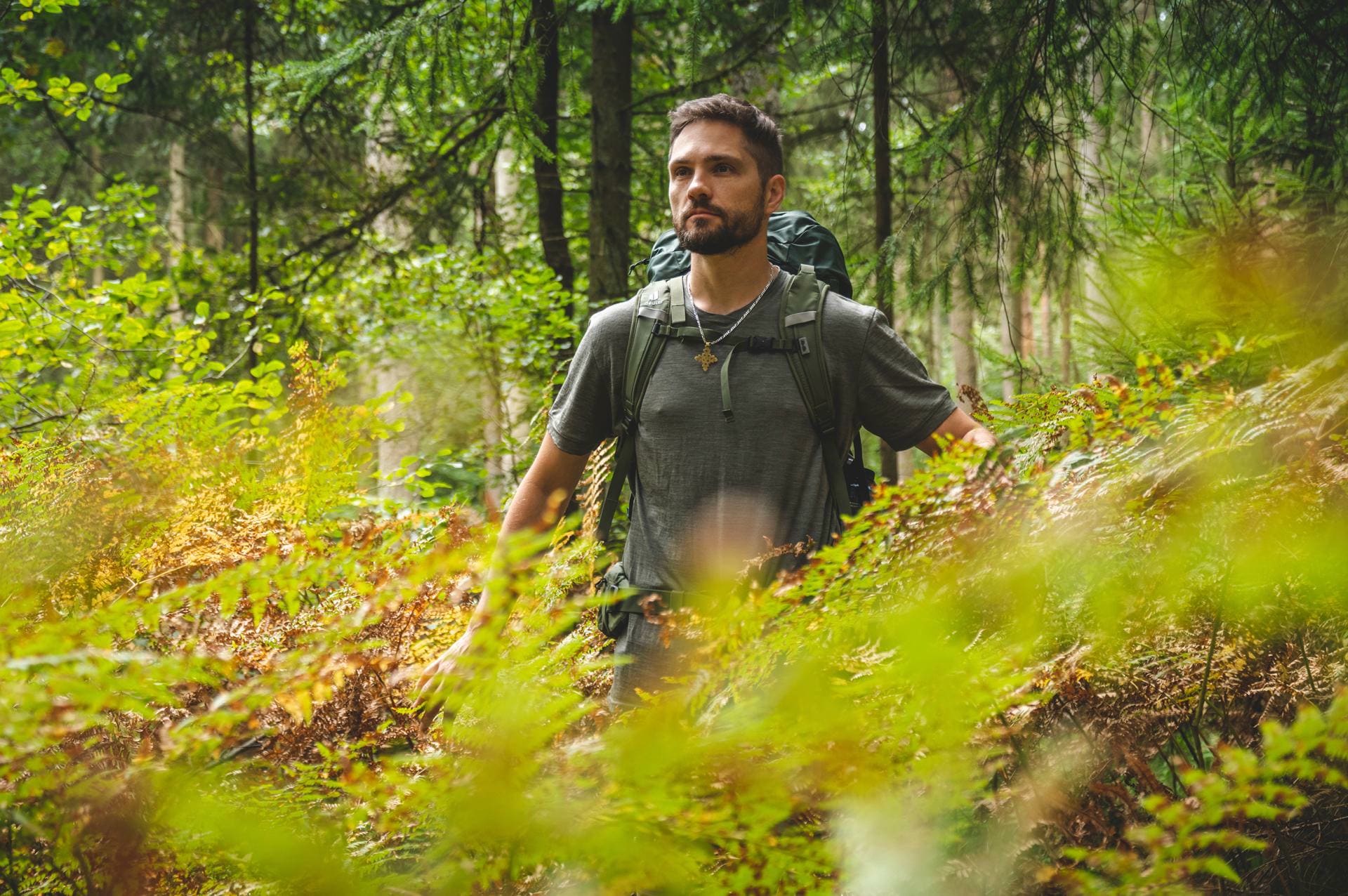A sunny Sunday morning in March. It's -4 degrees, wafer-thin white ice covers the puddles of water. Hoarfrost still lies in the shadows of the Hallertau, the Bavarian hill country where hops grow. My hiking colleague Tobias and I stand in the starting blocks with grins on our faces, anticipation written all over our faces. The reason: we want to try out several things that we have never done before. Firstly, we want to visit a natural monument that is still unknown to us, the inland dunes near Siegenburg. Secondly, we don't just want to hike there, we want to go on a pilgrimage. And thirdly, we want to see to what extent all of this fits into the simple, inexpensive, regional and affordable framework of a micro-adventure. Challenge accepted!
However, there was still one small obstacle... Although we both grew up in Roman Catholic Old Bavaria, where pilgrimages to Altötting, for example, are a tradition, we have never been on a pilgrimage. So we tried to explore the topic for ourselves. If you trace the word "pilgrim" back to its origins, you end up with the Latin adverb "per-egrē", which means "from, in, to a foreign land". A pilgrim also needs a symbolic destination, which is why we thought of the protected natural monuments. Research revealed that there are several such monuments here in Hopfenland: Rock faces, quarries, trees, pits, springs, caves, ponds, chapel mounds and... dunes. Dunes? That sounded promising. What's more, the nature reserve with the inland dunes near Siegenburg is located in the Dürnbuch Forest, which at 44.74 km² is one of the largest forest areas in Bavaria and which we have never hiked through before. The "being in a foreign country" thing was already going in a good direction. But would such a "short" pilgrimage also bring about the desired sense of coming to ourselves and slowing down? How would our trip differ from a normal hike? What would we find? We are curious.
We set off from Gosseltshausen near Wolnzach, the Holledau motorway junction sends its regards. we have 27 kilometres ahead of us. After just one kilometre, we discover a shady, steep meadow slope covered in hoar frost, topped by a vine of beech trees that only allows the gentle morning light to shine through in soft stripes. In the background, the undulating hills with reddish, wooden hop columns, that is vintage Hallertau - a dignified, solemn start that could not be better imagined for a nature pilgrimage. It's a quiet morning, only a few people are out and about. We catch a few puzzled glances, hiking "rucksack dudes" are a rarity here. The birds (goldfinch, skylark, green woodpecker, nuthatch, tits, mistle thrush, blackbird) that we heard at the beginning in the fields and between the vines and woodland strips are now only rarely heard from a distance. The tarmac and the silence around us make our voices sound lost.
We pass Niederlauterbach and soon see the pilgrimage church of Rottenegg on the opposite hill. Even though it demands an additional climb after a good seven kilometres, we can't miss this stop on our tour today. The view from the Calvary over the village and the hills is well worth the diversions. a castle was built here in 1150, as evidenced by the crypt, which is located a little below the mountain church and used to be part of the castle's cellar vaults. in 1704, the castle was badly damaged during the War of the Spanish Succession by plundering Austrian horsemen and English hussars. In 1722, Countess Rivera had a chapel built from the remains of the walls as a memorial to the former castle, next to which the grave of the French Brigadier General H. Lambert can still be found.
From Rottenegg, I head "into the unknown", while Tobi heads in the direction of his ancestors. We cross Obermettenbach on the 12 o'clock bell and, after a short hill rally in Oberpindhardt, discover a farm with a sign saying "der Schmie" - it is the farm where Tobi's grandfather's brother worked as a blacksmith. House names are a nice tradition in the rural area, so after the short historical excursion to the mountain church, we now add a piece of family history to the mix. We are already reminiscing about the generations before us, even before we are halfway along the route. As we approach a T-junction and wonder which way to turn, a grey-haired, friendly gentleman magically appears in the courtyard next to us, standing out from the rural surroundings in his perfectly fitting black and red Puma jogging suit. As it turns out, his style factor is just as high as his local knowledge. Pilgrim's luck. We pick up a few route tips and pass a steep meadow hill on the way to Aiglsbach, lined with resinous, fragrant wood at the foot and dotted with individual pine trees at the top. A wonderful little idyll that makes us think of the Altmühltal or Tuscany.
In Aiglsbach, we are greeted by another farm name sign, the "Urzt", which I find funny and strange because the "Urz" is the house name of the farm where I grew up. Neither my parents nor my brother or I have ever heard this name anywhere else, definitely a curious coincidence after the "Schmie". A few kilometres later, we arrive at the large forest, Dürnbucher Forst, and now it's time for a belated lunch break. Due to some intense photo sessions and my interval fasting, I haven't eaten for 18 hours and have unintentionally added an ascetic aspect to the pilgrimage. Before we enter the forest, we pass a nature reserve for meadow breeders and turn our backs on civilisation for the next 12 kilometres. There's still ice on the puddles of water, so when I turn round, there's a good chance Tobi is munching on fresh forest foamwort, whose flavoursome pungency is reminiscent of cress.
It soon gets lonely, the air is fresh and clear at 7 degrees, and stands of gorse indicate sandy soils. But in addition to the dry spots, there are also many springs and fish ponds with trout in this forest. The path names such as "Fürstenstraßl", "Stachus", "Spitzweg" or "Siegenburger Rittweg" don't tell us anything, but indicate that orientation plays a role here. The further we advance into the great solitude, the more the forest feels like another world. The meditative character that our hike now takes on conjures up the idea of a pilgrimage. After some time in silence, a small light suddenly wobbles towards us on an eternally long straight. We hear nothing and rub our eyes until we realise that it must be a cyclist. Dusk is not too far away, what is he doing here alone in the middle of this large forest? He eventually turns out to be a 20-something, Bavarian-speaking hipster who has simply set off on his "granny bike" in search of the road to Neustadt an der Donau. Of the rare human encounters today, this is the most bizarre. We help as best we can, but can't deny a certain lost-highway mood a la David Lynch.
1.5 kilometres before we arrive, the forest changes significantly: it becomes greener, more rustic, with more moss and heather, the air is more humid and it smells of mushrooms. Then a final twist that surprises and enchants us. The forest has turned into a grey-green, velvety shimmering hall. Its floor stretches out in long, gentle waves, covered by a carpet of moss and bilberry herb as well as tall, slender pines and scattered, delicate young trees. A small wonder that only reveals itself at the very end of our path. I've never seen a geotope like this in the Hallertau before. We are drawn further into the nature reserve and suddenly they are there: dunes of the finest drifting sand, up to ten metres high, blown here by winds in the last ice age. Only after they were sufficiently overgrown here in the inland did they stop moving. The dry, barren area is maintained so that rare animal and plant species such as the vernal park, the sand-straw flower and the blue-winged grasshopper can continue to exist in the tree-free, open areas with silver grass meadows and lichen carpets. That's why it's important to stay on the paths.
I take off my shoes, do a little shinrin yoku (forest bathing) at the edge of the path and soak up this special place with all my senses. The cold sand quickly refreshes me and walking barefoot is good for my feet. It was an enriching experience to hike through this natural monument and show it respect in this way. A wonderful day with many unexpected, enraptured and thought-provoking moments comes to an end. What remains is a feeling of humility and gratitude. If this is anything like the pilgrimage feeling we had in mind, Tobi and I have probably been on pilgrimages before without realising it.







